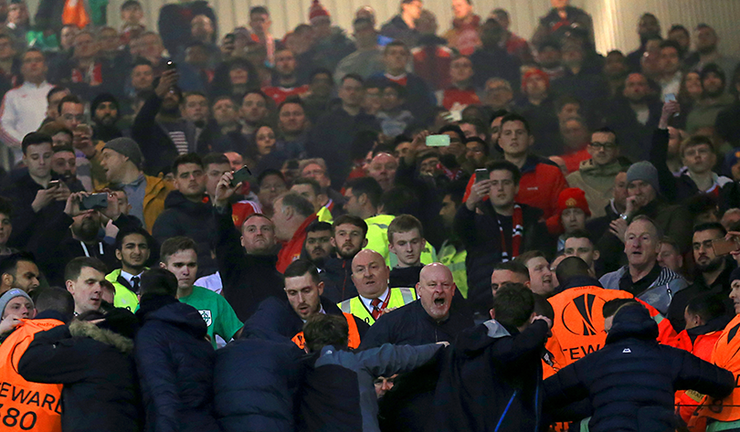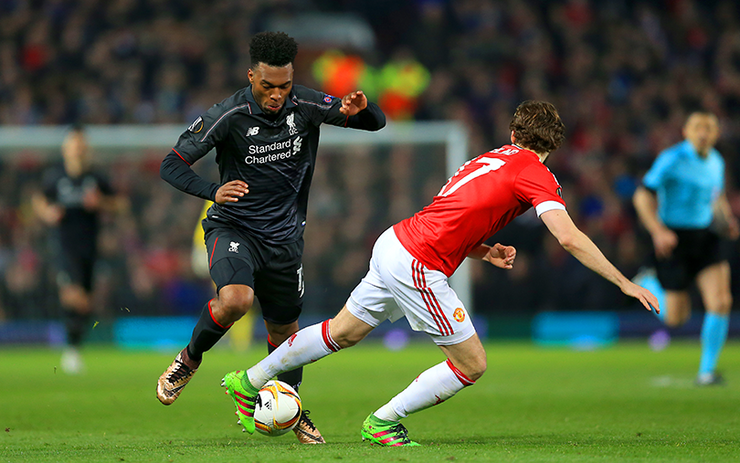50 Biggest Derbies in the World, №7: Liverpool vs Manchester United
The titanic clash between the north-west’s big two grabs a higher position than local battles with the noisy neighbours…
First things first: we’re perfectly aware, thanks, that each of these clubs has its own local derby with nearby shades of blue. And we know full well that those parochial affairs are intense and important, to local pride and national tables.
But if you ask most fans of these two teams which opponent they most want to beat, it’s that lot in red, at the other end of the East Lancs Road; that bunch with the daft accents, the smug superiority complex, the lack of class, the iconically imperious Scottish manager and the trophy list which isn’t quite as impressive. Their alter ego.
This clash of the north-west giants is in some ways the story of English football, or at least its last half-century. They have won 38 top-flight titles, while the rest of the country’s combined efforts come to 78; 24 of their triumphs came between 1973 and 2013, with each having a two-decade dominant period which no other English side has come even close to matching.
And their sibling rivalry is centuries old. Industrial Revolution powerhouses built on working-class populations with a strong Irish influx, they were linked by the world’s first passenger railway in 1830. But they had their squabbles, too: when inland Manchester thought the port of Liverpool was charging over the odds for trade, they dug a 40-mile Ship Canal and became the country’s third-biggest port.

Fans need to be calmed down following the recent UEFA Europa League clash
Rise and fall, fall and rise
Before the Second World War, the clubs weren’t even the biggest in their respective cities, but by the 1960s they were coming nicely to the boil. Led by two Lanarkshire friends, Bill Shankly and Matt Busby, the sides started to win competitions and fans, and there was mutual respect: United players would stand on the Kop to watch games, while in 1966 Liverpool fans voted Busby captain of their all-time XI.
United won England’s first European Cup in 1968, but Liverpool shifted into another gear just as the Red Devils drifted into a quarter-century title drought. That coincided with an increased hostility that still lingers, and in some ways worsened when the seesaw tipped in United’s favour. The derby day is still the most edgy on each club’s calendar, even if the atmosphere isn’t quite what it was in the terrace heyday of the 70s and 80s.
That atmosphere carried menace, though. As the avatars of big working-class cities suffering deindustrialisation and depression, each side attracted a hooligan element. The rivalry became malignant, revelling in violence and death, with small but vocal minorities enjoying sick chants about deaths affecting the others — Munich and Shankly, then Heysel and eventually Hillsborough.
As former United midfielder (and Kop-visitor) Pat Crerand put it: “When I go to Anfield now, I speak to long-standing Liverpool fans who can’t put up with what the rivalry has become: the hooliganism and the nastiness. Liverpool and Manchester are working-class cities that have produced two of the greatest football clubs in the world. People should be proud of that, but they’re not.”
Global brands
Compared to the ugliness of the 1980s, what some might call the gentrification of football in the Premier League era has made for a different sport. Quick to expand their footprint, on both the geography of a rapidly expanding Old Trafford and the economy of a TV-fed global market, United have benefited hugely, bankrolling more players for more success.

Daniel Sturridge takes on Daley Blind during the Old Trafford Europa League match
Liverpool, until recently more restricted by the neighbours and certainly less go-ahead commercially, have fallen further behind but still retain an enormous pull across the planet. Those lunchtime derby kick-offs aren’t merely to curb alcohol-fuelled aggro: they help to reach United’s 75m global fanbase and Liverpool’s 200+ fan clubs in 50 different countries.
It’s little wonder, really. Over the past half-century, games between these two world-famous sides have perhaps featured more iconic talent than any fixture bar El Clasico.
And those games have frequently been must-sees, either trophy deciders or simply barnstorming games. United’s 1977 FA Cup Final victory denied Liverpool what would have been a Treble, but Ronnie Whelan’s curled cracker won back some revenge as well as the 1983 League Cup. In 1994 Liverpool pegged champions United back from 3–0 down, but five years later United came back from a goal down in the last two minutes to win an FA Cup thriller.
Last word to Andy Mitten, the United fanzine editor whom FourFourTwo forced to sit on the Kop in 2007: “Separated by 33.3 miles of flat hinterland, England’s two biggest clubs provoke mutual loathing and haven’t conducted transfer business for 50 years, yet have more in common than not. Bound by suffering at Munich and Hillsborough, their greatest managers were Scottish, and both clubs enjoy huge matchgoing support in the largely working-class cities they call home. These bitter rivals are more alike than they’d care to admit.”
More Than A Game: Liverpool vs Manchester United
Originally published by FourFourTwo on April 29, 2016.



